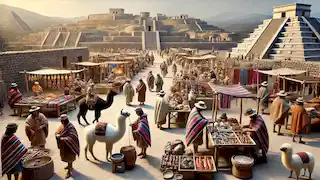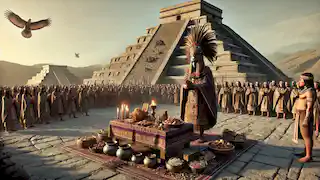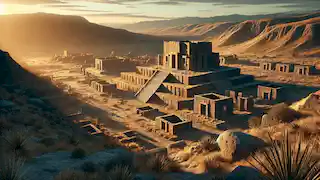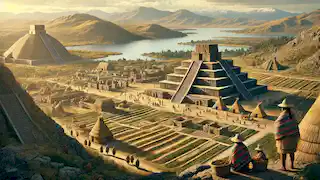The Tiwanaku civilization, a remarkable ancient society that thrived in the highlands of present-day Bolivia, is one of the most enigmatic and influential cultures in the history of the Andes. Flourishing between approximately 200 and 1000 AD, Tiwanaku became a powerful empire that extended its influence far beyond the boundaries of its capital city. This society was distinguished by its impressive architectural accomplishments, advanced agricultural techniques, and complex social and religious structures. Despite their extraordinary achievements, the Tiwanaku civilization left behind mysteries that scholars still strive to unravel today. What caused their decline? How did their religious and political systems function? What legacy did they leave for subsequent cultures like the Inca? This is the story of the Tiwanaku civilization, a people whose influence on the Andean region continues to captivate historians and archaeologists alike. The origins of Tiwanaku are rooted in the rugged terrain of the Altiplano, a high plateau located between the eastern and western ranges of the Andes. This region, with its cold climate and high altitude, was not a hospitable environment for human settlement. Yet, it was in this seemingly inhospitable land that one of the most advanced civilizations in pre-Columbian South America took root. The earliest evidence of human habitation in the area around Tiwanaku dates back to approximately 1500 BC. Small communities of herders and farmers began to settle near the shores of Lake Titicaca, one of the highest navigable lakes in the world. These early settlers relied on the lake's resources for survival, fishing its waters and cultivating crops such as quinoa and potatoes in the surrounding fields. As these communities grew, they began to develop new technologies to cope with the harsh environment. One of the most significant innovations was the creation of raised-field agriculture, a technique that involved constructing elevated plots of land separated by canals. These raised fields, known as *suka kollus*, improved drainage and prevented the frost damage that frequently occurred in the Altiplano's cold nights. This agricultural innovation allowed the Tiwanaku people to increase their food production and support a growing population. By around 400 AD, the small villages scattered around Lake Titicaca had coalesced into a more organized and centralized society. The city of Tiwanaku, located near the southern shore of the lake, became the heart of this burgeoning civilization. Over the next several centuries, Tiwanaku would grow into one of the most important cultural and political centers in the Andes. Tiwanaku's growth into a regional power was fueled by its mastery of agriculture and its strategic location near important trade routes. The raised-field system allowed the city to produce surplus food, which supported a large population and provided the means for Tiwanaku to expand its influence. At its height, the city of Tiwanaku was home to tens of thousands of people and covered an area of over 4 square kilometers. The city was divided into distinct sectors, each serving a specific function within Tiwanaku society. The most important of these was the ceremonial center, which contained the city's most impressive monuments and served as the focal point for religious and political activities. The city's architecture reflected the advanced engineering skills of its builders. Massive stone blocks, some weighing up to 100 tons, were used to construct temples, pyramids, and other monumental structures. One of the most famous of these is the Akapana Pyramid, a terraced platform that served as a religious and administrative center. Another iconic structure is the Gate of the Sun, a monolithic gateway adorned with intricate carvings of deities and celestial symbols. Tiwanaku's success was not solely based on its agricultural productivity and monumental architecture, however. The city also became a hub for trade and exchange, attracting goods and people from across the Andes and beyond. Tiwanaku merchants traded in products such as llama wool, obsidian, and copper, and the city's influence spread through trade networks that extended as far as the Pacific coast and the Amazon Basin. As Tiwanaku expanded its influence, it began to integrate neighboring cultures into its sphere of control. Unlike the later Inca Empire, which relied on military conquest to dominate its neighbors, Tiwanaku's expansion was more subtle and peaceful. It established a network of colonies and outposts that facilitated the exchange of goods, ideas, and people. These outposts helped to spread Tiwanaku's culture and religion across a wide area, creating a cultural sphere that extended from northern Chile to southern Peru. Religion played a central role in the life of the Tiwanaku civilization. The Tiwanaku people believed in a pantheon of gods, many of whom were associated with natural forces such as the sun, the moon, and the earth. Chief among these deities was Viracocha, the creator god who was believed to have brought order to the world. The Tiwanaku elite claimed to be descended from Viracocha, which helped to legitimize their political power. Religious ceremonies were held at the city's monumental ceremonial center, where priests and elite members of society would perform rituals to honor the gods and ensure the fertility of the land. These ceremonies often involved offerings of food, textiles, and precious metals, as well as the consumption of chicha, a fermented maize drink. The Tiwanaku society was highly stratified, with a clear division between the elite and the common people. The elite, who controlled the city's religious and political institutions, lived in large, elaborately decorated houses near the ceremonial center. The common people, by contrast, lived in more modest dwellings on the outskirts of the city and worked as farmers, artisans, or laborers. Despite these social divisions, Tiwanaku society was relatively stable and cohesive. The elite used religion and ritual to maintain their authority and ensure the loyalty of the common people. In return, the common people benefited from the prosperity of the city and the protection provided by the elite. By the beginning of the 11th century, the Tiwanaku civilization had reached the height of its power and influence. However, this period of prosperity was not to last. Sometime in the early 1100s, the city of Tiwanaku began to decline, and within a few decades, it was largely abandoned. The reasons for Tiwanaku's collapse are still the subject of debate among scholars. Some researchers believe that environmental factors played a key role in the city's downfall. There is evidence to suggest that a prolonged drought may have struck the Altiplano in the 11th century, severely disrupting the city's agricultural system. Without sufficient food, the city could no longer sustain its large population, and social unrest may have ensued. Others have suggested that internal political conflicts or external invasions may have contributed to the collapse of Tiwanaku. Whatever the cause, the once-great city was abandoned, and its influence faded. Although the city of Tiwanaku fell into ruin, its legacy lived on. Many of the cultural and religious practices that were developed at Tiwanaku were adopted by later Andean civilizations, including the Inca. The Tiwanaku people's agricultural techniques, artistic styles, and religious beliefs would continue to shape the Andes for centuries to come. Today, the ruins of Tiwanaku stand as a testament to the achievements of this remarkable civilization. The site, located near the modern-day town of Tiwanaku, has been designated a UNESCO World Heritage Site and is a popular destination for tourists and researchers alike. Archaeological excavations at Tiwanaku have revealed many insights into the city's history and culture, but much remains to be discovered. The city still holds many secrets, and scholars continue to study its ruins in an effort to better understand the civilization that built them. The legacy of the Tiwanaku civilization is not limited to the physical remains of its city. The cultural and technological innovations of Tiwanaku, particularly in agriculture, continue to influence the people of the Andes to this day. Raised-field agriculture, for example, has been revived in some parts of the Altiplano as a way to improve food security in the face of climate change. In addition, the religious and cultural practices of Tiwanaku continue to resonate in the Andes. The worship of Viracocha and other deities of the Tiwanaku pantheon persisted among the indigenous peoples of the region long after the fall of the city. Even today, some Aymara communities near Lake Titicaca continue to celebrate traditional festivals that are believed to have their roots in Tiwanaku. In conclusion, the story of the Tiwanaku civilization is one of remarkable achievement and enduring influence. Although their empire eventually faded, the people of Tiwanaku left a lasting legacy that continues to shape the culture and history of the Andes. From their innovative agricultural techniques to their monumental architecture and complex religious beliefs, the Tiwanaku civilization remains a source of fascination and inspiration for people around the world.The Origins of Tiwanaku
The Growth of Tiwanaku

Religion and Society

The Decline of Tiwanaku

Tiwanaku's Legacy

The Story of the Tiwanaku Civilization
Reading Time: 8 min

About Story: The Story of the Tiwanaku Civilization is a Historical Fiction Stories from bolivia set in the Ancient Stories. This Descriptive Stories tale explores themes of Perseverance Stories and is suitable for All Ages Stories. It offers Historical Stories insights. Uncover the mysteries of the Tiwanaku civilization, a powerful ancient empire of Bolivia that left a lasting legacy on Andean culture.

















